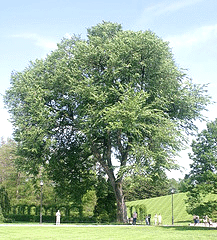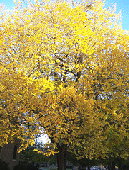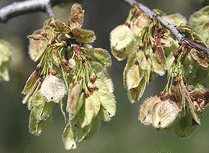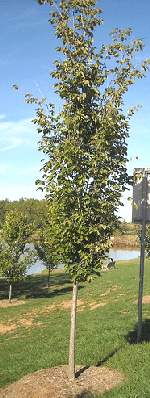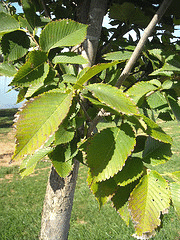American Elm Trees
American Elm is also known as White Elm, Water Elm, Soft Elm, Gray Elm, American Weeping Elm, Swamp Elm or Florida Elm
Ulmus americana American Elm
Zones: 2-9
Sun, tolerates light shade
Height: 80-100’
Spread: 60-120’
Shape: Broad to upright vase shaped crown
Growth Rate: Fast when young, moderate as it matures
Soil Preference: Tolerant of clay, loam or sand, preferring alkaline pH
Moisture: Average moisture needs, high drought tolerance
Foliage: Dark green, serrated
Blooms: Inconspicuous small green flowers in early spring
Fruit: Flat round green seed pods, turning papery brown
American Elm may once have been the most widely used landscape and street tree in North America before Dutch Elm disease devastated its’ population. Although sometimes difficult to find, disease resistant specimens are available through cloning and hybridizing. The easy to grow, very hardy and tolerant tree will live for 300 years or more. American Elm is a highly desirable shade tree with moderately dense foliage and a symmetrical crown in a broad or upright vase shape. When used as a street tree, shallow roots may displace sidewalks. It grows quickly when young, and at a more moderate rate as it matures. As with most fast growing trees, the American Elm’s wood is weak and susceptible to breakage. Pruning when young will help to develop a stronger structure. Once a strong crotch has developed, prune off all branches below the crotch. Also prune off all branches at any level that grows at a wide angle, preserving only upright growing branches. If pruned diligently in the first ten years, a strong structure and vase shape should maintain itself. The trunk will naturally divide into several large ascending limbs, producing gracefully drooping branchlets.
The American Elm is very well suited to cold climates, and is very tolerant of difficult conditions including drought, compacted soil, poor drainage and air pollution, and has a good tolerance to soil salt. It does prefer full sun in rich well drained soil, and will not grow as well in sand and drought or wet soil. The health of an American Elm should be consistently monitored for signs of disease. In addition to Dutch Elm disease, the elm may be afflicted with pests including bark beetles, gypsy moth, elm borer, mites and scales. Leaf beetles my consume large quantities of foliage, but will not necessarily damage the tree itself. Elm saplings are also one of deer’s favorite foods, so protect young elm trees or use a repellant. Maintaining an elm’s good health is essential. Elms transplant and establish fairly easily, ideally plant in rich soil with a pH of 6 or 7, full sun, and regularly water deeply until well established. Sprinkle a granular fertilizer in the root zone each fall, using a ratio of 5-10-5 or 5-10-10. Use a bark mulch (wood chip mulches absorb soil nitrogen) and do not smother the base of the trunk with deep mulch.
Insignificant flowers appear in early spring just before the leaves open. Small 1/2-1” round green seed pods follow, maturing quickly and eventually the wafer like pod turns dry brown. Seeds do not develop until the tree is at least 15 years old. Birds and wildlife enjoy the seeds, but large amounts are sometimes produced causing a mess on flat hard surfaces. Leaves turn a pleasant yellow in autumn.
Ulmus americana ‘Valley Forge’
Zones: 5-7, perhaps zone 4
Sun, tolerates light shade
Height: 60-80’, can reach up to 110’
Spread: One-half to two-thirds the height
Shape: Classic American Elm form, broadly vase shaped
Growth Rate: Fast
Soil Preference: Adaptable to poor soil conditions and tolerates road salt.
Moisture: Average moisture needs, with high drought tolerance
Foliage: Full dense canopy with lustrous dark green leaves, turning yellow in fall
Blooms: Inconspicuous small green flowers in early spring
Fruit: Flat round green seed pods, turning papery brown
‘Valley Forge’ is a pure ‘American Elm’ cultivar developed from seedling and shows high resistance to Dutch Elm disease, matching even the Asian elm to resistance. Along with ‘New Harmony’, they are the first commercially available Dutch Elm disease tolerant American elm trees, although neither is immune and may sometimes be difficult to find at retail nurseries. Several mail order nurseries have them available. These trees are wonderful selections for the home landscape, as they are also very tolerant of poor soil conditions, drought and air pollution. ‘Valley Forge’ like the ‘American Elm’, is very adaptable to adverse climate conditions that can sometimes be fatal to oak, maple and other popular trees. Tolerance to road deicing salt makes this tree an excellent candidate for street and boulevard trees, however shallow roots may displace sidewalks.
‘Valley Forge’ grows quickly, to 26’ and a 30’ crown spread in twelve years. Once established, growth rate can be as much as 3 feet per year. The ‘American Elm’ form is preserved in this cultivar with a broad vase shape and upright branches giving way to arching branchlets. As with the ‘American Elm’, crotch and structure weakness can be strengthened with pruning when young. Once a strong crotch has developed, prune off all branches below the crotch. Also prune off all branches at any level that grows at a wide angle, preserving only upright growing branches. If pruned diligently in the first ten years, a strong structure and vase shape should maintain itself.
Maintaining an elm’s good health is essential. Elms transplant and establish fairly easily, ideally plant in rich soil with a pH of 6 or 7, full sun, and regularly water deeply until well established. Sprinkle a granular fertilizer in the root zone each fall, using a ratio of 5-10-5 or 5-10-10. Use a bark mulch (wood chip mulches absorb soil nitrogen) and do not smother the base of the trunk with deep mulch Elm saplings are also one of deer’s favorite foods, so protect young elm trees or use a repellant.
Ulmus american ‘New Harmony’
Zones: 4b-7, perhaps zone 4a
Sun, tolerates light shade
Height: 68’
Spread: 72’
Shape: Broadly V-shaped
Growth Rate: Fast
Soil Preference: Adaptable to poor soil conditions and tolerates road salt.
Moisture: Average moisture needs, high drought tolerance
Foliage: Dark glossy green, turning yellow in fall
Blooms: Inconspicuous small green flowers in early spring
Fruit: Flat round green seed pods, turning papery brown
‘New Harmony’ is a pure ‘American Elm’ cultivar developed from seedling and shows nearly as high a resistance to Dutch Elm disease as ‘Valley Forge’, matching even the Asian elm to resistance. Along with ‘Valley Forge’, they are the first commercially available Dutch Elm disease tolerant’ American Elm’ trees, although neither is immune and may sometimes be difficult to find at retail nurseries. Several mail order nurseries have them available. These trees are wonderful selections for the home landscape, as they are also very tolerant of poor soil conditions, drought and air pollution. Tolerance to road deicing salt makes this tree an excellent candidate for street and boulevard trees, however shallow roots may displace sidewalks.
The trees grows quickly, once established will grow as much as 3 feet per year. The crown is broadly V-shaped with limb branches producing slender, somewhat drooping branches. As with the ‘American Elm’, crotch and structure weakness can be strengthened with pruning when young. Once a strong crotch has developed, prune off all branches below the crotch. Also prune off all branches at any level that grows at a wide angle, preserving only upright growing branches. If pruned diligently in the first ten years, a strong structure and vase shape should maintain itself.
Maintaining an elm’s good health is essential. Elms transplant and establish fairly easily, ideally plant in rich soil with a pH of 6 or 7, full sun, and regularly water deeply until well established. Sprinkle a granular fertilizer in the root zone each fall, using a ratio of 5-10-5 or 5-10-10. Use a bark mulch (wood chip mulches absorb soil nitrogen) and do not smother the base of the trunk with deep mulch. Elm saplings are also one of deer’s favorite foods, so protect young elm trees or use a repellant.
Ulmus americana ‘Princeton’
Zones: 3-9
Sun, tolerates light shade
Height: 60-100’’
Spread: 40-60’
Shape: Vase shaped
Growth Rate: Fast
Soil Preference: Adaptable to poor soil conditions and tolerates road salt.
Moisture: Average moisture needs, high drought tolerance
Foliage: Dark green large leathery leaves, turning yellow in fall
Blooms: Inconspicuous small green flowers in early spring
Fruit: Flat round green seed pods, turning papery brown
This 80 year old cultivar has thrived in the streets of New Jersey and has an extremely wide range of habitat, growing easily throughout Eastern and Central North America. Being very adaptable, it will also do well to the west coast and in the Southwest. ‘Princeton’s’ disease tolerance is comparable to ‘Valley Forge’, showing moderate to high resistance to Dutch Elm disease as well as elm leaf beetle. A true American Elm, ‘Princeton’ is produced from cuttings to preserve its’ classic attributes. It’s crown exhibits the classic vase shape, is dense and symmetrical with upright branches.
Like the other American elms, ‘Princeton’ is tolerant of road salt and urban conditions, serving well as a shade tree or boulevard tree. It is one of the most tolerant and adaptable of the American elms, growing well in frigid zone 3 and has proven to also do well as far north as zone 2, as well as dry regions to zone 9 and wet regions. Harsh pollution does not bother ‘Princeton’ other than sulfur dioxide pollution, making it an excellent choice in cities. A ‘Princeton’ elm tree will live well over 150 years. As with the American elms above, monitor branching habit and prune accordingly when young to promote strong crotch and structure, feed and mulch to maintain health as also noted above.
Ulmus americana ‘Jefferson’
The ‘Jefferson’ elm is a newer introduction, 2005, which is not yet available to the public but may be by 2009 or 2010. ‘Jefferson’ grows in the classic American elm vase shape reaching nearly 70’ tall. Broad U-shaped branch unions differ from the American elm, and the leaves turn dark green earlier in spring and stay dark through fall. Pollution tolerance makes it a good street tree and it is very adaptable. It is still being tested and has shown outstanding resistance to Dutch Elm Disease. ‘Jefferson’ elm is hardy in zones 5-7. More information will be added as it is available.
